
|
__________________________________________________________________
_________________________________________________
How the Kshatriyas became the "Protectors of Cows"
The fact that in the pastoral stage of Vedic society the main object of wealth and appropriation was cattle, is corroborated in Vedic literature by the word for war which is "Gavisti".
 | Gautam Buddha, was born a Kshatriya (member of the warrior caste). But his teachings represented human thinking quite in advance of his age. In an era (which still continues) where wealth, power, pride etc., were valued, he preached the values of simplicity, frugality, humility along with peace and universal love. He represents the human side of culture which has been the undercurrent of Hindu culture and in fact of all human culture across the globe, wherever the right thinking of humankind has prevailed. |
Gavisti literally means "A search for cows". The basic social unit in those days of a pastoral society was the Gotra which literally means a cowpen or cow shed. The Kshatriyas of every tribe had the function of not only acquiring cattle reared by other tribes, but also protect the cattle that belonged to their own tribe. Herein could lie the origin of the concept of Kshatriyas being protectors of cows.
This was how the actual medium of transformation could have been, through which Aryan (and human) society passed from the sustenance stage to the stage characterized by the rising productive power.
This lead to the accumulation of wealth and the consequent grabbing of wealth from other humans, necessitating the formation of the martial caste of soldiers - Kshatriyas in the Indian context.
As long as society remained a tribal one, devoid of any caste division, all activities had been collective, there was no specialization. Every member of the tribe participated in hunting, food gathering, waging wars, defending his tribe from outside attackers, etc. In this tribal set up all decisions were taken collectively by all adult members of a tribe. In Vedic literature we are told that every tribe had institutions called the Sabha and Samiti on which all adult members of a tribe were represented. No doubt the smallness of individual tribes made this kind of representation an easy task. A tribe is referred to by the word Gana in Vedic literature. Gana means a collection (of people). Thus we can infer that as far as organisation goes the tribal Vedic society of the Aryans was loosely organised as compared to the regimentation of later Hindu Society based on the social stratification of Chatur-Varna or four varnas (castes). The word Gana implied the loosely organised tribal groupings of the early Vedic age whose disintegration was brought about by the new productive forces whose muscle power was represented by the Kshatriyas.
Transition from Tribal Democracy to Monarchy
The transition from the Gana tribal democracy to absolute monarchy with the strictly ordered social structure of Chatur-Varna took place as a long drawn process within the progressively withering (Gana-tribe).
 | Buddha lived in a society where caste distinctions were emerging. But the Buddha's message of a society free of caste divisions impressed many great minds across all ages and nations. In India we had powerful kings like Samrat Ashok Maurya, Kanishka, and Harsha who patronised Buddhism. From other parts of the globe too (mainly the far east) many thinkers visited India. They included Fa Hien, Huen Tsang, I Tsing. Buddhism has exercised a sobering influence on a large part of humankind. |
As mentioned earlier, the improvement in labour productivity resulted in a surplus in production which was in excess of human needs of sustenance. The existence of such a surplus fomented a greed for its appropriation which drew man to battle his own kind. This surplus was appropriated either in the form of grain, cattle, and also in the form of members of other tribes who were to be enslaved and tied down to work for their masters, in other words to give their masters the surplus in production which the rise in human productivity enabled them to create.
 | As warfare among the tribes, to appropriate the other tribes surplus wealth in grain and cattle, became a regular feature there arose the necessity for a full-time (i.e. standing) army, a full-fledged military apparatus complete with its commander-in-chief. Thus the technique of warfare and weaponry increasingly came to be monopolized by a few of the more well-built members of the tribe on a permanent basis. Seen here is a typical Kshatriya in traditional dress. |
Warfare among the tribes, to appropriate the other tribes surplus wealth in grain and cattle, now became a regular feature and along with this regularity there arose the necessity for a full-time (i.e. standing) army, a full-fledged military apparatus complete with its commander-in-chief. Thus the technique of warfare and weaponry increasingly came to be monopolized by a few of the more well-built members of the tribe on a permanent basis. This was in contrast of the former practice of al1 members of - the tribe being trained in warfare and who would take up weapons in the eventuality of defending the tribe or attacking other tribes.
In the changed circumstances, the tribal chieftain came to be elected from these select full-time warriors who were originally called Rajanyas (those - warriors - other than the king) in Vedic Literature. Their chief was called the Rajan who initially wielded power by posing to be an observer of the tribal interests.
The tribes now faced the threat of enslavement by being subjugated by another tribe's warriors. The people of the tribal Gana had to thus accept the till then unimaginable phenomenon of differentiation amongst its own members. The development of productive forces, the rise of surplus and its appropriation by the stronger tribes, left no choice, for the weaker tribes and weaker members of a tribe, but to accept this phenomenon.
But actually, in the long run the Kshatriya warriors of the mutually battling Ganas (tribes) were not to be protectors of the tribe to which they belonged from the possibility of enslavement by the warriors of another tribe they were to be the pall-bearers of the tribal society and foster-fathers of the caste-based monarchical states that were to arise later.
With the further development of productive forces and rise in the surplus, also rose the greed for its appropriation and the consequent incessant warfare, the select tribal warriors who gradually acquired the hereditary status as Kshatriyas (which translates as "Protectors") is derived from Kshatra (which means "Protection") claimed monopolistic rights to wield weapons and acquire the skill of warfare along with the de facto right to have one of them elected as chieftain of the tribe. They had come to acquire this right to chieftainship on strength of the custom which had given them the position of being 'Protectors' of the withering tribal society.
 | A symbol of Kshatriya Martial Prowess - The Kirtistambha (tower of fame) and the adjoining temple at Chittodgad. |
Now the remaining members of the tribe called Vis (meaning laity) came under the effective domination of the Kshatriya warlord and could question the regal authority only at the risk of being silenced forever.
This section of the laity referred to as Vis in Vedic literature later came to constitute the Vaishya peasant-cultivators of Hindu society. This process had as an impetus for its development, the quantitative narrowing down of that section which had the hereditary right to hold weapons. In the beginning a large part of the tribe' s members must have been in the group that held weapons, from the fact that in the near past all members of the tribe had that right (and duty). But, as the process of division of society into specific categories (or classes) proceeded, this right to hold weapons increasingly devolved upon a shrinking but powerful minority till ultimately it vested on a very select group (the rudimentary army of Rajanyas or Kshatriyas) and the most powerful amongst this group was of course elected chief (Rajan) of the tribe till as long as the tribal set up survived.
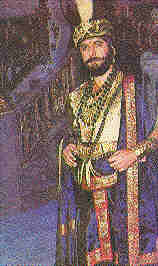 | The Kshatriyas were called Rajanyas (those - warriors - other than the king) in Vedic Literature. Their chief was called the Rajan - the Rex, Roi or King. |
But the existence of the tribe was now only formal, the executive authority had already passed into the hands of the Rajan - the chieftain of the Rajanyas (Kshatriyas).
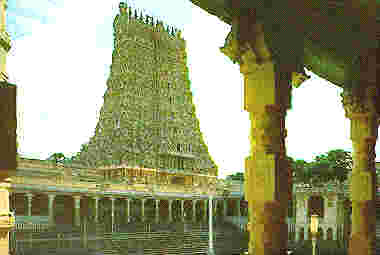 | Till the dawn of the 20th century and the reforms to the temple entry rules, many castes were traditionally not allowed to enter into the precincts of a temple. The entry into the sanctum sanctorum is still restricted to the priests in many temples today. The rigid social structure associated with Hinduism and which goes against the spirit of humaness as enshrined in the philosophy associated with Hinduism, needs to be revamped so that it corresponds with the kernel of the Hindu outlook based on principles of Vasudaiva Kutumbakam (The World is One Family) and Ekam Satya Viprah Bahuda Vadanti (Reality is one, people - belonging to different religions - call it by many names). Names like Sri-Ram, Sri-Krishna, Christ, Jehovah, Allah or for that matter, as a rationalist like me would say, that part of reality which is beyond human knowledge today. Seen here is the Raj-Gopuram (Spire) of a temple at Madurai. |
The depriving of the general population of military training and the formation of a professional warrior-caste was necessary for the systematic subjugation of a major section of society consisting of the conquered peoples of various tribes and to function as a guardian of the group interests of the military caste. The following Mahabharata episode of Ekalavya and Dronacharya illustrates this.
Ekalavya was the son of a Nishada (tribal) chieftain. The Nishadas were looked upon as non-Aryans by their Aryan neighbours. Hence even in spite of their martial temperament, the Nishadas were never admitted to ashramas in which all Kshatriya boys were admitted to be given education especially in the martial arts. But Ekalavya was a restless boy, when he was about seven years old he witnessed the five Pandava princes who were of his age being imparted military training by Dronacharya in his ashram. As the young Ekalavya thirsted for acquiring military training he hesitantly approached the Sage Droncharya with a request that he also be allowed to join the ashram. Upon being asked to state his background Ekalavya admitted that he was Nishada.
On hearing this the ruffled Dronacharya curtly told Ekalavya that he could not accept a Nishada as his pupil. However, if Ekalavya could find another Guru he would be able to acquire military education. Undeterred by this rejection Ekalavya went back to his home deep into the forest and decided that if Dronacharya himself could not be his Guru, he would mould a statue of Dronacharya and acquire military training before the statue, which he would look upon as his Guru.
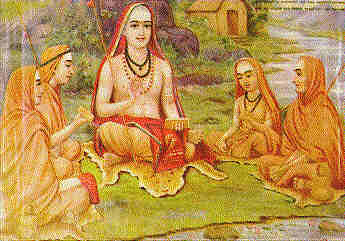 | An Ashrama - As the rights to acquiring education were monopolised by the Brahmins, so also the rights to acquire military training came to be traditionally monopolised by the Kshatriyas. However, through the ages, the Brahmins, could preserve their monopoly over acquiring education in the shastras, but the Kshatriyas could not. This was so as repeated waves of invaders came into Indian society and many of them (before the coming of the intolerant Muslims) got themselves baptised as Kshatriyas and merged into Indian society. |
Days passed by and unknown to Dronacharya his pupil Ekalavya surreptitiously acquired military training. Ekalavya mastered the art of archery and started putting it into practical use. One day a dog was disturbing his practice of archery. Master archer that he was, he shot a number of arrows into the dog's open mouth such that the dog could no longer bark, but not a drop of blood fell from its mouth. The dog scampered away from Ekalavya and reached the place where Dronacharya and his entourage were taking rest.
Seeing the dog, Dronacharya realized that the archer who had done this was no ordinary one. So he sought to search him out. When after some time he saw a young tribal boy practicing archery, he called out to him. Whereupon, the boy fell at Dronacharya's feet. When Ekalavya modestly admitted that it was he who had shot aroows skillfully into the dog's mouth, Dronacharya asked him who his Guru was? The unsuspecting Ekalavya told Dronacharya that he himself had taught him to do so.
On hearing this, Dronacharya was dumbfounded. On being explained by Ekalavya that he had installed a statue of Dronacharya and that he looked upon Dronacharya as his Guru; the sage was perplexed that a Nishada boy who had no right to acquire military training as per caste rules had done so by looking upon Dronacharya himself as his Guru. What way could Dronacharya deprive Ekalavya of the knowledge he had acquired. To this dilemma, Dronacharya struck upon a wily technique. He blessed Ekalavya for having looked upon him as Guru but said that for having done so Ekalavya would have to give Guru-dakshina (the fees of a Guru), to which Ekalavya readily agreed. Little did Ekalavya know that the Guru-dakshina would be nothing short of his right Thumb, in other words his art of archery itself!
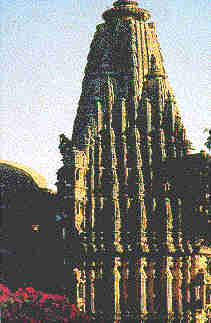 | Temples such as this one could be seen by members of some castes only from the exterior. Many Hindu saints (from all castes including the upper castes) protested against such discrimination. Among them were Tulsidas, Ravidas, Nanak, Basaveshwara, Tukaram, Namdeo, Dynaneshewar, and many others. Seen here is the Shikhara (Spire) of a temple at Jodhpur in Rajasthan. |
On Dronachrya's demanding Ekalavya's right thumb, the dutiful Ekalavya sheared off his thumb and laid it at Dronacharya's feet. The Guru-dakshina had been redeemed and so had been redeemed the ruthless demands of the caste system which reserved the right of acquiring military training only for the Kshatriyas.
But the above stratification among members of the tribe which regularised warfare not only led to the grabbing of the accumulated wealth of one tribe by another but it also led to a widening gap in the shares of the different groups within a tribe in the looted wealth. Before the division of the tribe had taken place into sections of priests, warriors and the remaining population, whatever product was acquired either by industry of the tribe's members or from the looting of another tribe, had to be shared equally amongst all members.
The act of distribution of the collective wealth was enforced by tribal morality upheld by the Samiti representing all members of the tribe. But as the above discussed stratification became dominant, the Kshatriya warlords were the ones who got hold of most of the protect which they acquired by looting other tribes. They could also appropriate a large part of the wealth produced by the laity (Vis) of their own tribe also, by means of the brute strength they now wielded over the entire tribe. They had to do this appropriation of the wealth (food, clothing, arms etc.) produced by the lay members of their tribe as they themselves gradually gave up physical labour which they came to look upon as ignoble.
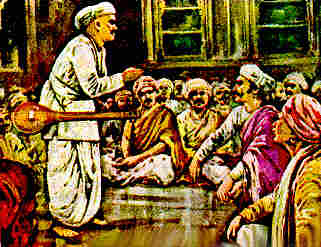 | Saint Tukaram from Maharashtra was a Vaishya by caste. He preached against caste discrimination. He was a devotee of Lord Vitthal of Pandharpur. Tukaram was harassed by the Orthodoxy and was made to drown his writings (Abhangas) in the Indrayani river at Alandi. By his kirtans however, he exercised a powerful influence against caste discrimination. |
This approach of theirs was later formalised in the Chatur-varna morality in which it was the Dharma (the righteous duty) of a Brahmin to acquire education, that of a Kshatriya to fight, of a Vaishya to produce and a Shudra to undertake menial labour. In the environment the tribal society was in its final stages and its formal end came about when the members of different castes who till then had belonged to different tribes (or Gana-Gotras as they are termed in Vedic literature) were absolved from having the membership of a particular tribe.
This loosening of tribal kinship was brought about by the abandonment of marriage within one Gotra.
Upto then, marriage within one Gotra was the norm. This was called Sagotra Vivaha (i.e. marriage within a gotra) and no person was allowed to marry outside his tribe (i.e. outside his Gana-Gotra}. But when the new circumstances necessitated that the tribal set-up be dismantled this morality was reversed and where earlier marriage outside a Gotra was forbidden, now marriage within one Gotra was forbidden and marriage within one caste (Sajatiya Vivaha) was made the rule.
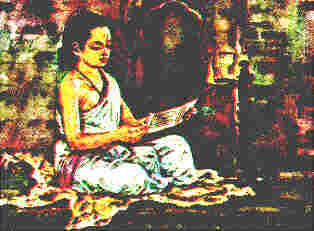 | Sant Dyaneshwar lived and died young. He was born a brahmin, but his father had become a Sadhu after his childhood marriage. On coming to know of his marriage, his Guru asked Dyaneshwar's father to return to family life (of a Grihasta). After this Dyneshwar and his three brothers and a sister were born. As they were the progeny of an apostate monk, the orthodoy out-casted them and made life difficult for them. But Dyaneshwar protested against this treatment and preached against such discrimination and against distinctions based on caste. |
The very fact that Sa-gotra marriage was forbidden, proves that it existed before it was forbidden. One need not forbid what has never been done.
Till today we traditionally observe this rule of having marriage outside our Gotra and within our caste. This ban on marriage within a Gotra with the requirement of marriage within one's caste Jati-Varna) gradually but completely delinked the different members of a tribe and linked up those belonging to a particular caste. With the passage of a few generations the tribal set-up had been totally erased and its place had been taken by the new alignments of Brahmins, Kshatriyas, Vaishyas and Shudras as per the requirements of the Chatur-Varna, ideology of a caste based society.
The existence of tribal equality and the absence of crimes like robbery, acquisition of wealth, etc., were absent in a tribal society on that lived at sustenance level. The people were poor, but lived together happily. This state was fableized and was poetically recollected as Krtayuga or Satyuga (the age of truth) which degenerated into the later ages of Tretayuga, Dwaparyuga and the present Kaliyuga.
_________________________________________
Now we move on to examine how the Chatur-Varna Hierarchy was really a Two-Fold Division between the productive and the non-productive categories.
_____________________________________________________________
_____________________________________________________________________________________
|
|
_ _ _ |
View My Guestbook
|
_______________________________________
_________________________________
